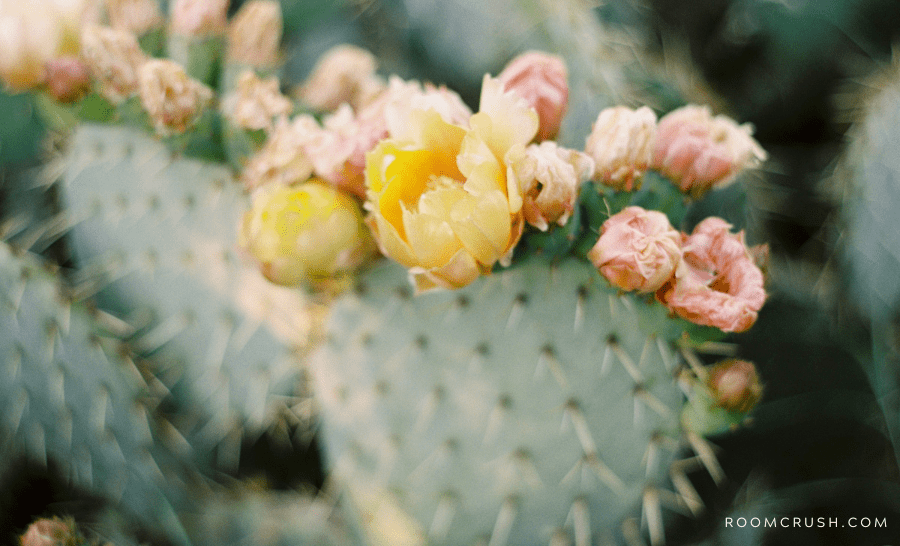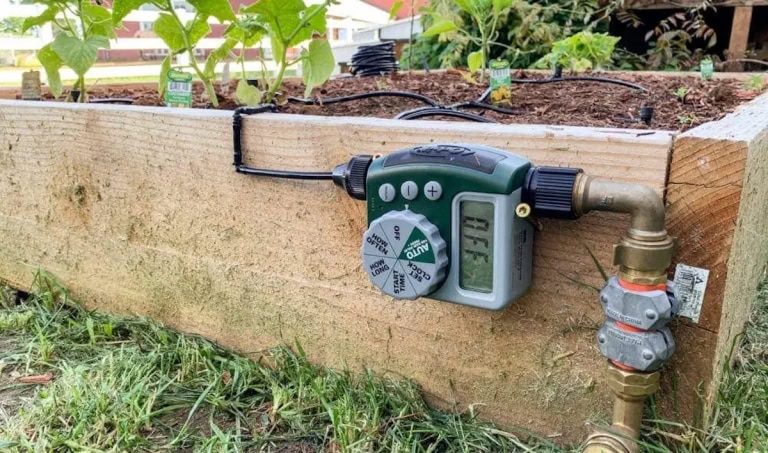How Do You Start & Care For A Cactus Garden

How Do You Start & Care For A Cactus Garden? Cacti are such a popular choice of home plants for a variety of reasons. They have a distinct appearance that enhances the beauty of your home or landscape, are easy to maintain, and have a long lifespan, even in neglect.
Thus, perfect for both beginners and pro gardeners who desire to spruce up their spaces with plants.
While cacti are succulents, not all succulents are cacti.
This site uses ads and affiliate content as an Amazon associate earning on qualifying purchases. Disclosure.
The Unusual Seeds Blog says, a cactus is a plant within the Cactaceae family with succulent stems and branches, and with scales or spines instead of leaves, and with solitary, but very showy flowers.
Also, all cacti have “areoles” – these are specialized short shoots that produce spines, normal shoots, and flowers.
There are so many varieties of cacti, but grouped into two:
- Desert cacti and,
- Forest cacti.
While desert varieties are suited for hot, desert conditions, forest cacti can survive steamy, humid environments. However, both of these plant groups are able to store water within their leaves, stems and sometimes, roots.
To choose either of these species as you start a cactus garden, learn their various adaptations in their various environments:
| DESERT CACTI | FOREST CACTI |
| Originate from areas of hot, dry, arid conditions thus suited to such environments | These mostly grow in shaded forests as epiphytes. Thus, thrive in humid conditions. |
| Most species have a spreading fibrous root system. This enables them to feed quickly as soon as moisture hits the ground. Some varieties have a tap-root system which they use to store water, thus, the root will literally swell up. | These species cling to branches and use their roots to anchor themselves on the host plant, for light, and absorb water from their host plant. |
| Have spines to prevent water loss from the plant, and collect mist and dew to will feed the plant essential moisture. | Have larger, more waxy leaves than Desert species to attract pollinators and allows them to reach optimum sunlight levels for energy |
| The body of the cacti swells with water and is covered in clusters of spines that produce side shoots and flower blooms. | They display wonderful tropical flowers in forest canopies throughout the seasons |
| Grow in very free-draining soils. TIP: When planting cacti outdoors, choose a sloped location whenever possible. This allows for better drainage. Also, if starting a cacti container garden, ensure it also has drain holes to help with quick-draining | Require light yet well-draining soils with a small amount of well-rotted organic matter. TIP: When potting up forest cacti, use light and crumbly substrate mix like a sandy, free-draining potting mix with a small amount of well-rotted organic matter or garden compost added to it. |
| Thrive in temperatures above 60 degrees F, (16 degrees C) and will survive in temperatures down to as low as 41 degrees F, (5 degrees C), throughout the winter when dormant. | Thrive in areas of high humidity with temperatures above 50 degrees F, (10 degrees C). |
Most gardeners and homeowners grow desert varieties because they require less maintenance, unlike forest varieties.
Now let us help you start a cacti garden in your home- whether to adorn your landscaping or your indoor decor, here are the tips on how to grow and maintain cacti:
How To Grow Cacti Plants In Your Home, Whether Garden Or Indoors
Cacti are great plants to have in your home or landscape, and their visual experience, especially when they flower, adds such beauty to your space.
However, for your cacti to grow and flourish, you need to be keen on their lighting requirements, drainage and air requirements, soil conditions, and watering requirements. Here is what you need to know:
Lighting Requirements
Cactus plants love light, with the majority of cacti being able to withstand strong, direct sunlight. Therefore, when growing cactus, choose a location that receives enough sunlight, whether indoors or outdoors.
For an outdoor cactus garden, an ideal area is an area that gets a minimum of 6 hours and a maximum of 8 hours of sunshine daily for your cacti to thrive.
If growing cactus indoors, position them in the sunniest spots in your home, ideally, a south-or-east-facing, sunny window that gets 6-8hrs of daily but indirect sun. Just be sure to turn the plants regularly to make sure all sides of the plant get equal sun exposure.
Remember to adjust lighting based on seasonal changes. For instance, if you bring your cactus indoors during the winter, continue to provide it with the light it needs. You might need to expose it to 12 to 14 hours of full-spectrum light that provides all the wavelengths that sunlight provides, giving your cactus the light it needs.
You can use A Plus LED Grow Lights for Indoor Plants √ or this Fauna 100W COB Plant Grow Light Full Spectrum, which has a timer to manage the hours of light you expose to your cactus.
While cactus species flourish in bright light, they tend to scorch and bleach in intense, direct sunlight coupled with high temperatures. Prevent this by moving your plants to a shady area when the sun gets too hot.
Also, insufficient sunlight will cause your cacti to grow tall and thin and have inconsistent growth patterns in search of the light it needs through the process of etiolation. In addition, the plant will not be able to flower since it does not have enough exposure to sunlight for photosynthesis.
Soil & Drainage Requirements
Fast-draining soil is ideal for cacti. As a result, if possible, plant your cacti on a hill. Better drainage is possible as a result of this.
Cacti do not grow well in ordinary garden soil. Root rot is caused by soils that can retain water for an extended period of time. As a result, use porous soils that allow water to be easily absorbed and then quickly drained while still retaining some moisture and nutrients.
You can either prepare a potting soil mix and grow your cacti in containers outdoors or prepare the ground soil to receive your cacti.
Water Requirements
Underwatering is one of the most common cactus mistakes; people believe that since cacti can survive in hot conditions, they can go for weeks without water. A cactus that is not given enough water will normally die; despite their toughness, they need daily watering to thrive, just like other plants.
Cactus owners can also overwater their plants. The water can accumulate at the bottom of the pot, causing root rot. As a result, it’s critical to realize that while cacti are drought-tolerant, they prefer a dry environment.
You must closely analyze your plant’s actions to determine if it requires water. When pressed gently, a completely hydrated cactus plant feels “hardy” and easily regains its form.
However, if a cactus is under-watered, its body can typically appear wrinkly and feel “soft.”
The spines appear to be dry and can fall off easily. Overwatered cacti will appear soggy, mushy, and translucent.
Also, before watering your cactus plant, make sure the soil is fully dry.
Ideally, a cactus should be watered once a week, according to experts at the San Jose Cactus & Succulent Society. This is while your plant is growing.
Indoor cacti can go two weeks without watering, while most outdoor cacti need weekly watering.
When watering your plants, soak them thoroughly until you see the water draining out of the drain holes or down the sloppy land. Make sure the soil is loose, completely dry but not too dry and cracking. The end result should be damp but not wet soil.
When the temperature drops in the winter, there is still a lot of humidity in the air. To avoid a cactus with rotting roots, avoid overwatering your plants. In this case, water for longer periods of time and always enables the soil to dry out between waterings.
Know what kind of cactus you’re dealing with. It’s important to understand where your cactus comes from. Some cacti grow in arid climates thus little water, while others need your protection from the sun and may need more water.
Also, cacti that are younger need more water, while those that are older need less.
Feeding Requirements
Cacti aren’t heavy feeders, so they won’t need much fertilizer. So, unless your cacti are winter-hardy, fertilize them only when they are growing, and stop fertilizing in late summer to prevent any new growth in the winter.
They thrive when fed a heavily diluted all-purpose fertilizer, despite the fact that they don’t need a special fertilizer mix. For example, a 10–10–10 fertilizer (equal parts nitrogen, phosphorus, and potassium)
You can use the following cactus fertilizers:
- EarthPods Premium Cactus & Succulent Plant Food √ to stimulate robust root growth, stem development & color vibrancy.
- Schultz Cactus Plus Liquid Plant Food to help new cactus plants take off.
- Grow More Cactus Juice to provide calcium and other nutrients to cacti and succulents for greener and healthier cacti.
Remember to always follow the instructions of your cactus fertilizer even before use.
Otherwise, feeding the plant incorrectly might kill it instead of promoting healthy growth.
Dealing With Cacti Problems
When cactus plants are properly cared for and kept in the right climate, they thrive. Cactus plants, like others, show symptoms of illness when improperly handled, that must be identified and treated as soon as possible.
Cacti are slow-growing plants that take a long time to mature. It’s possible that you’ll mistakenly believe your plant is dead when it’s actually alive and well.
One of the most common cactus problems that any gardener should be aware of is root rot. Overwatering can lead to rotting roots, so provide just enough water as your cactus requires..
There are also occasions when the cactus simply uses stunted growth as a warning sign. Perhaps due to rotting or overcrowding that can stunt growth. Address this by repotting your cactus plants once they become overcrowded.
To ensure that your cacti grow in good health, keep an eye out for broken stems and provide treatment to prevent cacti diseases.
How To Plant Cactus In Your Garden, Indoors & Outdoors
Planting a cactus garden isn’t difficult; however, there are a few precautions to take to ensure that you plant it correctly.
Most cactus plants can be purchased already growing, so all you have to do is to place it in a suitable container, or dig a hole and place the cactus in it. However, there are several differences from standard transplantation procedures.
Planting Indoor Cacti
Cacti will grow in your home and flourish. All you need is a sunny window to bring a little bit of nature into your home.
Get started with the right kind of container and soil mix.
When selecting a container:
Make sure it has drainage holes to allow excess water to drain. If it doesn’t have them, make sure you drill them before planting your cactus in it. Also, select a container that is only wide enough to accommodate the cactus.
Also, the pot’s depth should be proportional to your cactus’ natural growing process. If your cactus grows tall and has deep roots, you’ll need a large pot to hold them.
Terracotta pots are ideal for cactus gardens as water evaporates faster through them than through other products.
However, they are very fragile, and if they fall or strike something solid, they will break. In addition, the water will dry out quickly in the summer due to its high drainage rate. Sometimes, the cactus roots might penetrate the clay pot walls.
Plastic pots are also a popular choice for many gardeners.
You May Also Like: Hanging Basket Garden? Learn How to Make a Hanging Garden
To get your cactus soil mix right:
Mix organic material (to help provide nutrients for your plants) with non-organic material to make your cactus potting soil (to help with drainage). One-third compost, such as bark or peat moss, one-third horticultural sand, and one-third grit, such as dirt, perlite, or pumice, make up a strong cactus soil mix.
The Hoffman Organic Cactus & Succulent Soil Mix √ is an organic cactus and succulent soil mix you can use with both jungle and desert cacti. This ready-to-use mix is pH balanced and provides the drainage cacti need to flourish.
To pot your cactus:
- Fill the pot about 1/3 full with the cactus soil mix and center the cactus in the container, while wearing thick gardening gloves.
- Using your cactus potting mix, fill in the remaining space.
- Gently press the soil down between the cactus’ roots.
- Place the container in a window that faces the south or east.
- Water your cactus plants.
TIP: You can still bring these cactus container gardens outdoors and grow them in planters. This is a good idea if you don’t have much planting space.
You May Also Like: The Best Indoor Plants For Beginners
Indoor Cactus Decor Ideas
1. A mini cactus garden in a glass vase or terracota pot.
2. Display your mini cactus garden on surfaces like your consoles or even, tables.
3. Grow cactus in containers and display by the window.
4. Mix cactus and succulents in tiny planters on the decorative tray.
5. Grow cactus in large planters and display in a corner receiving much sunlight.
Planting A Cactus Garden Outdoors
If you’re going to grow a cactus outside, late spring to early summer is the best time to do so. The plants are actively growing during this time and will develop their roots more easily and have an easier start.
Also, pick an area that receives full sun.
- Begin by mixing equal parts of native soil and cactus-friendly garden soil from a garden supply store in the planting field. You can also use a potting mix with potting soil, coarse sand, like sandbox sand, and pumice or perlite for good drainage, instead of the soil in your yard to ensure adequate drainage and aeration.
- Dig a deep hole twice the width of the root ball or stem of the cacti you intend to transplant outside.
- Place the plant in the cavity, making sure it’s in the same position it was before it was transplanted.
When transplanting or relocating the plant, it’s important to always know its orientation—ideally, marking its previous orientation and the side where light comes in with a chalk and ensuring the mark faces the same direction no matter where the plant goes.
You should inquire at the garden center, and when planting, place the plant in the hole so that the north side of the plant faces north, and the south side faces the south.
Since it receives more light, the south-facing side of the plant usually grows thicker skin that is more tolerant of the sun than the north-facing side, which may not be able to withstand the sun as well.
- Pull the soil away from the root ball and gently pat it down.
- To settle the plant, give it a light watering.
- Give your cactus some food. To encourage root absorption, use cactus fertilizer every time you water your plants. You may even consider using properly composted cow manure.
- As your plants grow, mulch your cactus plants with a medium layer of rocks or pebbles. This also adds to the aesthetic appeal of your landscaping.
After watering the cactus the first time, wait at least a week before watering again to allow the cactus to recover and take root. After that, all you have to do is weed your cactus garden and apply fertilizer as needed.
You may want to give your cactus some shade right after planting until the roots have established themselves. You may use a shade cloth or a nearby plant to provide temporary shade.
Outdoor Cactus Landscaping Ideas To Try
1. A cool desert cactus garden all over your yard.
2. Mix different shapes and sizes of cactus with other tall plants for additional interest.
3. Grow cactus in different sizes of terracotta planters and align by your fence for an instant statement.
4. Display cactus among other climbing plants in tall planters on your balcony.
5. Decorate your patio tables with cactus groupings.
6. Feature cactus in groupings to create a focal point.
6. Create a vertical cactus garden.
7. Grow cactus in an old, broken-down car for a unique feature in your yard.
8. Grow cactus in neat raised garden beds.
9. Mix stones or rock mulch with cactus to create a Zen cactus garden.
Planting a cactus is simple if you do your homework. Choose the right cactus for the right place and soil for a successful cactus garden. Now go, and start a thriving cactus garden!







